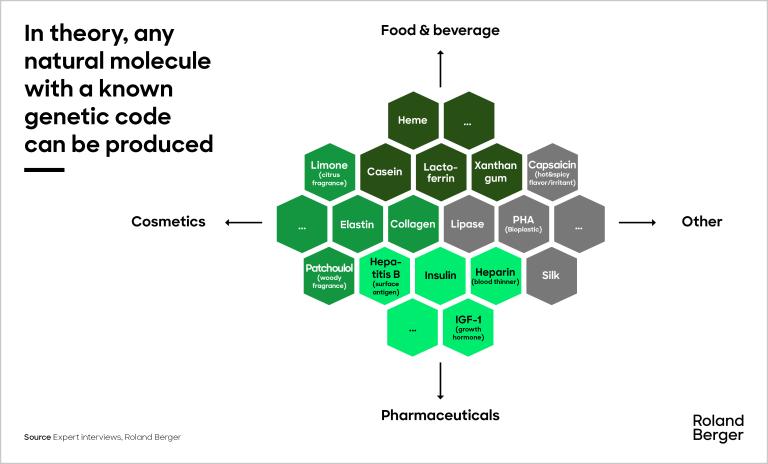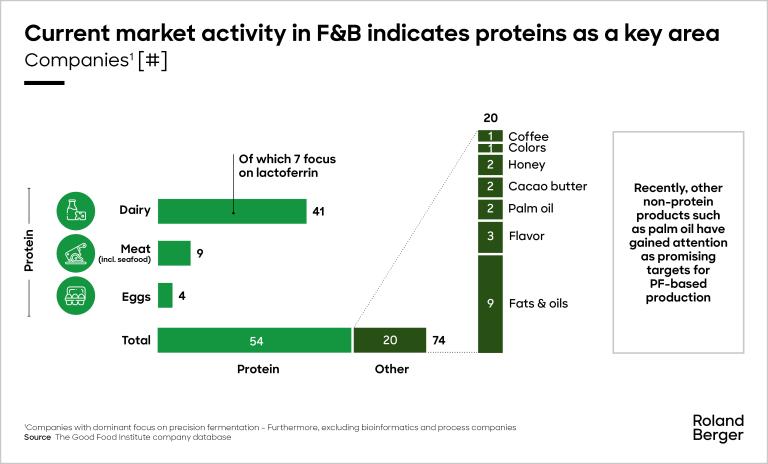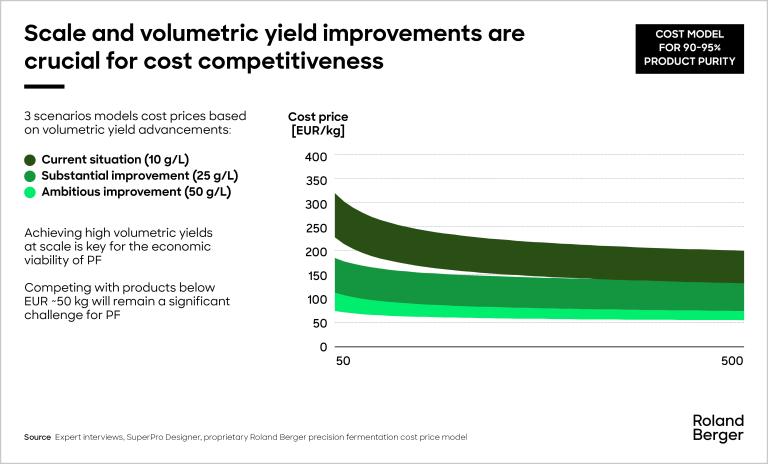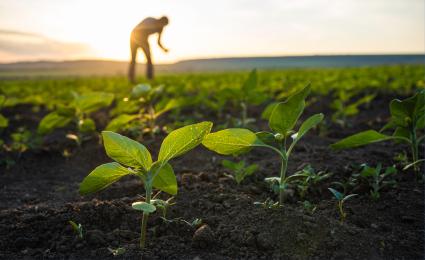Roland Berger experts can deliver tailored solutions to global players throughout the consumer goods, retail, and agriculture value chain.


The promise of precision fermentation: Can it really change the game?
Versatile and promising technology
Precision fermentation, which uses genetically engineered microorganisms to produce a target end-product, is gaining traction. Seemingly poised to disrupt key areas, and with its economic viability expected to improve, can it truly become a game-changer?

"Precision fermentation offers game-changing potential for specialty molecules, but economic viability remains challenging for commoditized products, even with significant yield improvements."
Versatile and promising technology
Of the three types of fermentation – biomass, traditional and precision – precision fermentation is the most versatile. In precision fermentation, the microorganism is genetically engineered to produce a target molecule, the target molecule in this process is chemically identical to its naturally occurring counterpart. Precision fermentation has a number of advantages over biomass and traditional fermentation, including broader applicability, higher yields and customizability. In theory, any natural product with a known genetic code can be produced with precision fermentation.
Precision fermentation directly produces single molecules, an outcome which would require a high degree of processing in traditional methods. It has the potential to disrupt the production method of various molecules, especially those with intensive processing requirements, insecure supply chains, synthetic labeling, or sustainability and ethical concerns. The most promising molecules for disruption exhibit several of these characteristics.
Moves in F&B
Precision fermentation is making important strides in key application areas such as food & beverage, cosmetics, and pharmaceuticals. Food & beverage (F&B), particularly, is seeing a surge of established and new players looking to cash in on its promise. DSM-Firmenich and Fonterra, for example, joined forces in 2023 to launch the startup Vivici, which is set to commercialize animal-free dairy proteins. Additionally, new entrant EVERY, which makes animal-free egg proteins, raised USD 233 m in funding rounds.
Protein is a clear focus of much of the current precision fermentation activity in F&B. About 75% of the industry’s precision fermentation companies concentrate on protein production, mainly dairy proteins. The other 25% focus on ingredients like fats & oils, flavors, palm oil and cocoa butter – a part of the industry that has been showing significant activity recently.
Overcoming obstacles to wider application
Precision fermentation still faces significant challenges to its wider application. However, these challenges are expected to see positive developments in the coming years.
We are expecting headway in consumer acceptance and regulation , for example. Consumers, who are becoming increasingly aware of labeling, sustainability and ethics of the products they buy, have historically shown a willingness to purchase precision fermentation-derived ingredients like rennet (cheese ingredient) and riboflavin (vitamin B2). Regional regulatory frameworks are also expected to become more unified as more and more precision fermentation products enter the global market.
Key challenges persist, though, when it comes to the cost-competitiveness of precision fermentation. Price parity with traditional production methods remains challenging due to scale limitations and process inefficiencies. Nevertheless, recent years have seen significant investments and start-up activity. Furthermore, key cost reductions across the value chain, especially in raw materials and strain development, are expected.
Such moves will undoubtedly help the situation, but ultimately it is scale and volumetric yield improvements that will be crucial for the economic viability of precision fermentation in the long run. At demo scale (100 m3 or less), the cost price of a precision fermentation-derived end-product is high, but the cost price drops at higher scale and from 300 m3 becomes relatively stable. It is volumetric yield, however, that promises to have the most impact on the cost-competitiveness of precision fermentation. In our modeling of a yield increase to 50 g/L, the cost price per kilogram of product drops significantly, across both CAPEX and OPEX.
Game-changer in specialty molecules
Based on our proprietary model, precision fermentation shows game-changing potential for specialty molecules, but economic viability is low for more commoditized ones. Even at large-scale capacity of 500 m3 and ambitious yield improvement to 50 g/L, the cost price for a 90% purity product is still expected to be EUR ~50/kg. This implies a significant gap with commoditized products such as cocoa butter, coffee, palm oil and whey hydrolysate, where typical market prices are below EUR 15/kg.
The cost-competitiveness of precision fermentation can be further improved by several factors. Low inclusion rates, for one, will dampen the effect of cost differences. Small cost markups could therefore be justified by natural claims or supply security. Secondly, precision fermentation could be performed using raw materials with negative cost prices, such as CO2 or waste streams, driving down costs. Thirdly, when the product has lower purity requirements, this would also allow for less complex and costly processes, especially downstream. Fourthly, technological disruption in (downstream) processes such as continuous fermentation and reductions in consumable costs, could further improve cost-competitiveness, albeit with significant challenges. Lastly, the prices of traditionally produced products could rise due to factors like scarcity or carbon taxes, which would benefit the competitiveness of the precision fermentation route, as well.
If you would like to dive deeper into our numbers or the promise of precision fermentation in general, get in touch with one of our experts for our full report.










_person_320.png?v=852316)
